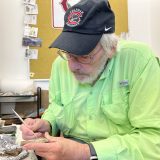
From Swamp Monsters to Anteaters Alumni Spotlight: Swamp Monster Alumna Kristin Gabriel '16
June 11, 2019
Sporting their Swamp Monster pride, three alumnae from Dr. Jason Keller’s lab got together for a photo-op wearing their lab shirts and to connect with each other for the first time. Research in Dr. Keller’s lab focuses on understanding how ecosystems function and how these functions will respond to ongoing global change. Most of the work explores anaerobic carbon cycling in wetland ecosystems, ranging from northern peatlands to coastal salt marshes. Undergraduate collaborators are heavily involved in this research and gain first-hand experience in conducting and presenting scientific research. He branded his lab members as Swamp Monsters due to their research in swamp-like places.

Kristin Gabriel (left), Emily Hanna (center), Ari Jong (right)
Dr. Keller connected these three alumnae when he learned they were all attending graduate programs at the University of California, Irvine (UCI).
At Chapman, Ari Jong ’16 was an environmental science and policy major. She is now working on her Masters in Environmental Engineering. Emily Hanna ’18 was a biological sciences major, and following graduation started her Masters of Public Health. Kristin Gabriel ’16 majored in biochemistry and molecular biology, with a minor in environmental science and policy. She is now, as Dr. Keller says, “crushing” her Ph.D. in Molecular Biology.
We sat down with Kristin Gabriel to learn how her experience working as a Swamp Monster helped her to pursue her Ph.D. at UCI.
Q: How did you get involved with the Swamp Monsters during your time at Chapman?
I got involved with the Swamp Monsters during my freshman year at Chapman. I assisted Kylle Roy, a senior, on a marsh organ project exploring the effects of sea level rise on microbial respiration at Brookhurst Marsh in Huntington Beach, California.
Q: What was your experience like being a part of the Swamp Monsters? Do you have a favorite memory?
My experience being a part of the Swamp Monsters was an awesome opportunity to have as an undergraduate. I enjoyed taking the lead on a project exploring the role of water-table level on humic substance reduction in northern peatland soils. In order to perform this work, I engineered an apparatus to collect soils anaerobically and developed a novel research technique. My favorite memory was presenting a poster on this work at the Society of Wetland Scientists Meeting in Providence, Rhode Island.
Q: What skills did you take away from that experience?
As a Swamp Monster, I learned how to communicate my research in peer-reviewed journals and conferences to promote scientific literacy in the community. Our findings showed that the water-table level can be an important control on the suppression of methane production in wetlands resulted in my first author publication! I also learned how to think creatively about science and gained a broad-based training, in topics from ecosystem ecology to biochemistry, that allow me to pursue my Ph.D. research with an interdisciplinary perspective.
Q: What led you to choose your current program at UCI?
I was drawn to the Cellular and Molecular Biosciences program at UCI because it’s an environment with expert researchers and cutting-edge laboratory techniques that encourages students to become superior scientists, researchers, and public leaders.
Q: What advice would you give to current students who might be considering a graduate program after college?
I would recommend current students who might be considering a graduate program after college to seek guidance from faculty mentors. While I was at Chapman University, the guidance I received from Dr. Jason Keller, Dr. Marco Bisoffi, and Dr. Milton Greenberg opened my eyes to all the options of graduate school.

